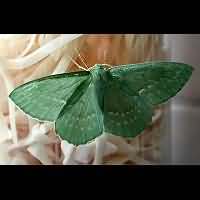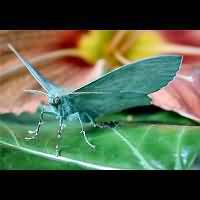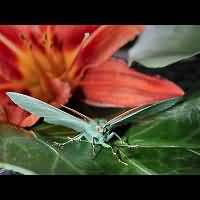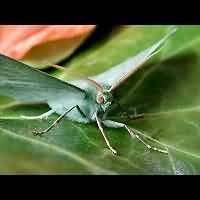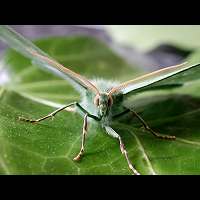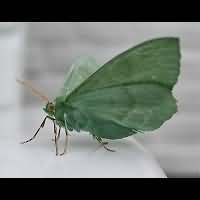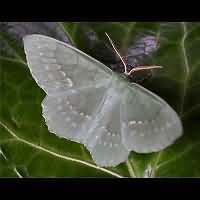Large Emerald (Geometra papilionaria)
The Large Emerald is among our largest Geometers. There are more green Geometers looking a bit like it, but it is by far the largest. It does look a lot like a butterfly, as indicated by the scientific name. Not only because of the beautiful colour, but also because of the size. The Large Emerald is about as big as the Large White or the Admiral. Even the way the animal sits reminds one of a butterfly, for the wings are not pressed against the surface it is sitting on, but kept slightly upwards, like many butterflies do when visiting a flower. The animal is pale green with two lines of white v-shaped markings, even though in some cases one of the lines can be hardly visible or might even be missing. The body is covered in green hairs and so is the first part of the legs. One main difference exists between butterflies and our Large Emerald. The latter mostly flies by night and that is a pity. Sometimes it does fly by day, but always at great altitudes. Contrary to many other green Geometers, the Large Emerald hardly ever looses its green colour. It is rare to find an old one where the green faded into some pale kind of yellow.
The eggs hatch in August and September mainly. The small, brown larvae will feed for some time, then will seek a place to hibernate. They spin a small bed on the surface of a twig or the stem of the tree, near a bud and sleep on their own mattress. By the end of April the caterpillars awake and start eating. They also start turning green. The adult caterpillars are green with bumps on the back, brown warts on the side, the head is green as well, but there is a brownish glow over it. They will reach a length of some 30 mm and differ immensely from the young larvae. To pupate the caterpillar drops down to the earth or looks for mosses on branches of the tree. It then spins a thin cocoon between some leaves or debris. Inside it will pupate, which takes about 4 weeks. The caterpillars live on Birch mainly, but have been found on beech, alder and hazle as well.
There is only one generation a year, flying about for a relatively short period of time, for it is usually seen in July only. Some specimens do fly a little earlier or later though. The Large Emerald prefers birchy woodlands on light soils. It is a common species in many parts of Britain, if conditions are right. In Scotland widespread but local. It flies from midnight to dawn mainly and is eager te explore artificial light sources.
The Large Emerald is among our largest Geometers. There are more green Geometers looking a bit like it, but it is by far the largest. It does look a lot like a butterfly, as indicated by the scientific name. Not only because of the beautiful colour, but also because of the size. The Large Emerald is about as big as the Large White or the Admiral. Even the way the animal sits reminds one of a butterfly, for the wings are not pressed against the surface it is sitting on, but kept slightly upwards, like many butterflies do when visiting a flower. The animal is pale green with two lines of white v-shaped markings, even though in some cases one of the lines can be hardly visible or might even be missing. The body is covered in green hairs and so is the first part of the legs. One main difference exists between butterflies and our Large Emerald. The latter mostly flies by night and that is a pity. Sometimes it does fly by day, but always at great altitudes. Contrary to many other green Geometers, the Large Emerald hardly ever looses its green colour. It is rare to find an old one where the green faded into some pale kind of yellow.
The eggs hatch in August and September mainly. The small, brown larvae will feed for some time, then will seek a place to hibernate. They spin a small bed on the surface of a twig or the stem of the tree, near a bud and sleep on their own mattress. By the end of April the caterpillars awake and start eating. They also start turning green. The adult caterpillars are green with bumps on the back, brown warts on the side, the head is green as well, but there is a brownish glow over it. They will reach a length of some 30 mm and differ immensely from the young larvae. To pupate the caterpillar drops down to the earth or looks for mosses on branches of the tree. It then spins a thin cocoon between some leaves or debris. Inside it will pupate, which takes about 4 weeks. The caterpillars live on Birch mainly, but have been found on beech, alder and hazle as well.
There is only one generation a year, flying about for a relatively short period of time, for it is usually seen in July only. Some specimens do fly a little earlier or later though. The Large Emerald prefers birchy woodlands on light soils. It is a common species in many parts of Britain, if conditions are right. In Scotland widespread but local. It flies from midnight to dawn mainly and is eager te explore artificial light sources.

